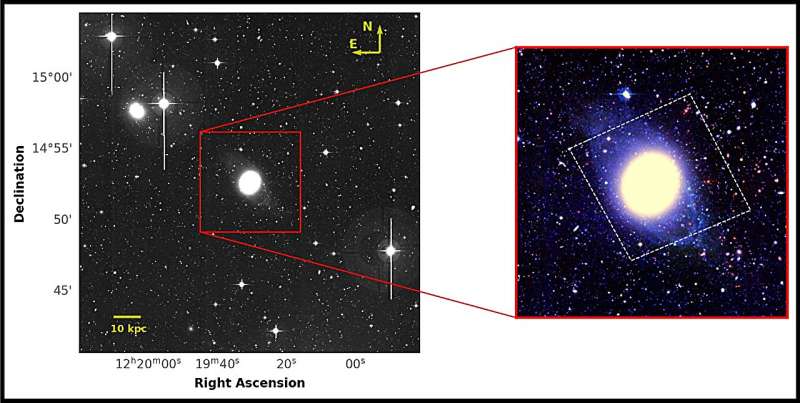Optical g-band image of NGC 4262 taken with CFHT. The horizontal solid yellow line in the lower left corner indicates an image scale of 10 kpc. The inset shows an optical color image with a field of view of 7×7. This image of the galaxy reveals an optically faint ring component that has remained undetected in earlier optical images. In the inset, the white dashed line represents the HST ACS observation area. Image credit: Krishna R et al., 2024.
Indian astronomers have conducted extensive and in-depth field observations of a polar ring galaxy named NGC 4262 using the Canada-France-Hawaii Telescope (CFHT). arXivto learn more about this galaxy’s globular cluster system.
A so-called polar ring galaxy (PRG) is a system consisting of an S0-like galaxy and a polar ring that have remained separated over billions of years. Generally, these outer polar rings are composed of gas and stars and are roughly perpendicular to the main axis of the central host galaxy.
NGC 4262, located approximately 50.5 million light-years away from Earth, is the closest PRG to Earth and a member of the Virgo Cluster. It is a gas-rich galaxy with an apparent magnitude of approximately 12.49.
Although many studies have been conducted on NGC 4262, its globular cluster system (GCS) remains unexplored. That’s why a team of astronomers led by Akhil Krishna R of Christ University, Bangalore, India, used CFHT’s MegaCam instrument to study GCS in this galaxy. The observations were conducted as part of the Next Generation Virgo Cluster Survey (NGVS).
“This study extensively investigated the GCS properties of PRG NGC 4262 using wide-field optical images obtained from the Canada-France-Hawaii Telescope,” the researchers wrote.
Astronomers have obtained the first optical image of NGC 4262, which contains optically faint ring components. The image shows that NGC 4262 has a bar-like structure within a radius of 20 arcseconds from the center of the galaxy, and a polar ring structure after a radius of 50 arcseconds from the center of the galaxy.
Observations found that NGC 4262’s GCS contains at least 266 globular clusters spanning 124,000 light-years. The total mass of the system was calculated to be 63.8 million solar masses.
Based on analysis of the radial distribution of GCS in NGC 4262, the astronomers found a color gradient of -0.05 within 5.5 arcminutes, beyond which it transitions to a flat profile. This discovery points to past interactions within NGC 4262 and to a transition from a dissipative to a dissipative mechanism in the evolutionary history of the galaxy’s GCS.
Given the slight deviations observed in the radial and azimuthal distributions of GCS, the spatial and azimuthal distributions of stellar subpopulations provide further confirmation of past interactions within NGC 4262.
The study also found that NGC 4262 has a specific frequency of 4.2 and a specific mass of 0.23. The researchers say this number is relatively high compared with other galaxies of similar mass and similar environments.
Summarizing the results, the paper’s authors concluded that their findings suggest that NGC 4262 has a transitional phase between spiral and elliptical galaxies.
“The high specific frequency of NGC 4262 is at a position close to that of an elliptical galaxy, which indicates that the GCS properties of PRG are more similar to elliptical galaxies than spiral galaxies. All these results indicate that NGC 4262 has the potential to become an elliptical galaxy and is currently under study.” Based on Its GCS properties are in a transitional state,” the scientist explained.
More information:
Akhil Krishna R et al., “Beyond the Rings: The Polar Ring Galaxy NGC 4262 and its Globular Cluster System”, arXiv (2024). DOI: 10.48550/arxiv.2404.10059
Journal information:
arXiv
2024 Science X Network
citation: Observations exploring the globular cluster system in the galaxy NGC 4262 (2024, April 23), retrieved April 23, 2024, from https://phys.org/news/2024-04-explore-globular-cluster-galaxy -ngc.html
This document is protected by copyright. No part may be reproduced without written permission except in the interests of fair dealing for private study or research purposes. Content is for reference only.
#Observation #exploration #globular #star #cluster #system #galaxy #NGC
Image Source : phys.org
